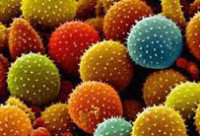 H.G. Wells’ classic “War of the Worlds” is a tale about how some of the smallest creatures on Earth ultimately destroyed Martian invaders wielding technology powerful enough to wipe out humanity. His idea was not entirely fanciful; as global warming lifts the average temperature of our planet and invasive species spread due to global travel, fungal spores – amongst the smallest of things – are decimating entire ecosystems, despite the power of human science.
H.G. Wells’ classic “War of the Worlds” is a tale about how some of the smallest creatures on Earth ultimately destroyed Martian invaders wielding technology powerful enough to wipe out humanity. His idea was not entirely fanciful; as global warming lifts the average temperature of our planet and invasive species spread due to global travel, fungal spores – amongst the smallest of things – are decimating entire ecosystems, despite the power of human science.
We are now witness to a real War of the Worlds: the very small against a much larger foe, but this war is of humanity’s making. Global average temperature is the highest it has been in very long time, and appears to be headed far higher. If the average temperature ultimately reaches an increase of 7-10 degrees fahrenheit the world will be warmer than it has been in 800,000 years, and this in a period of only 200 years, coincident with the burning of fossil fuels. Yet even a very modest rise in average temperature appears to have profound effects on the biosphere.
Sudden Oak Death killing trees, White Nose Syndrome killing bats, and Chythrid fungus killing frogs are emerging signs of a major change in global biological systems affecting plants and animals. This shift may presage what Earth scientists are recently calling The Sixth Extinction, the looming disappearance of half, or more, of the planet’s plant and animal species.
In the case of Trees and Sudden Oak Death, the culprit is Phytopthora ramorum, a fungus-like, water-based species of mould that does not require living in large bodies of water. Research indicates it is a non-native, introduced species. It’s suspected that the present shift in average global temperatures has given Phytopthora an edge over Oak trees, just enough to overwhelm its plant defenses.
White-Nose Syndrome, due to a fungus called Geomyces destructans native to Europe, has quickly spread within America’s susceptible bat population; for them, it’s lethal and many millions have died. Consuming mostly insects, including an uncountable number of mosquitos, bats also are primary pollinators for several fruiting plants. They occupy a unique niche among mammals, one that is unlikely to be replaced.
Biologically far older than mammals, amphibians represent a genus that formed the bridge between animals living in water and animals living on land. Amphibians inhabit both, hatching with gills from eggs deposited in water and later emerging from water with lungs and able to breathe on land. Amphibians are found world-wide, except at the poles, and like bats they consume a huge number of insects. Chytrid fungus, highly toxic to amphibians, has now been spread world-wide, and amphibian species too numerous to count have disappeared. These are just obvious examples, as is the undoing of our local crab season due to toxic algae in the warming Pacific waters.
Undoubtedly, extinctions happen, as they always have, in many places for many reasons, but never before has the planet’s temperature risen so quickly in just a few centuries. Comparable shifts in the past have taken tens of thousands of years, or even millions. An exception might be when an asteroid hit Earth, darkened the skies and killed off the dinosaurs. In some sense, humanity’s burning of fossil fuels is an “asteroid” of extinction.
Our War of the Worlds may doom bats and amphibians; whether humanity survives is now in large part up to us.





Be First to Comment